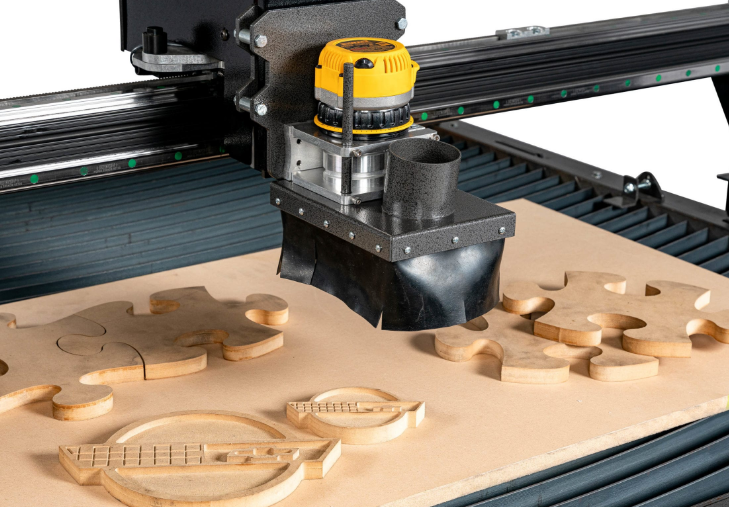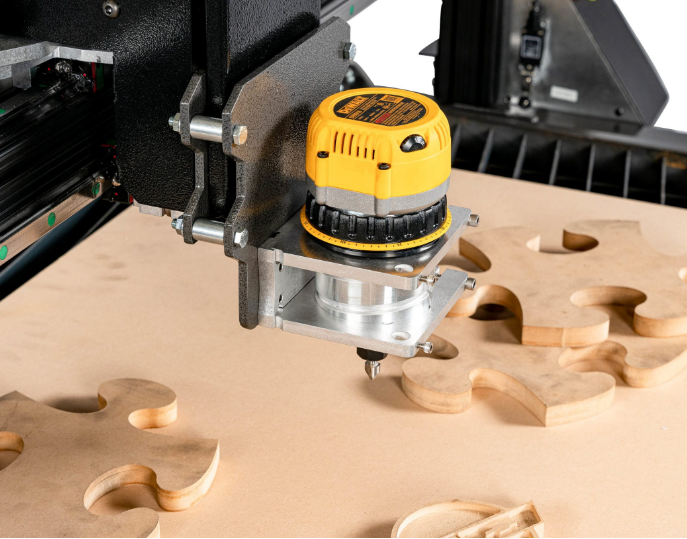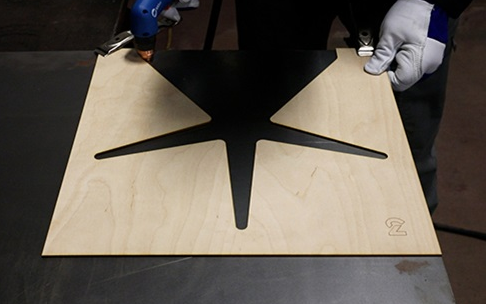Plasma Cutting Basics
Plasma cutting is a versatile and efficient process used in various industries for cutting conductive materials, primarily metals. Understanding the fundamentals of plasma cutting is essential for those looking to utilize CNC technology for precision cutting.
The Plasma Cutting Process
The process begins with the injection of a gas, typically air, oxygen, nitrogen, or an inert gas, into the plasma torch. This gas flows through a narrow nozzle.
An electrical arc is created within the nozzle using a high-frequency spark. This arc ionizes the gas, turning it into plasma—the fourth state of matter—composed of hot, ionized gas particles.
The plasma jet directed toward the workpiece reaches temperatures of up to 30,000°F (16,650°C). This intense heat melts the metal at the point of contact.
Simultaneously, a high-velocity gas jet surrounds the plasma arc, blowing away the molten metal, creating a clean cut.
CNC technology plays a crucial role in controlling the movement of the plasma torch. It precisely follows the programmed cutting path, ensuring accuracy and repeatability.

How CNC Technology Enhances Precision
CNC (Computer Numerical Control) technology allows for precise and automated control of the plasma cutting process. Operators can program the CNC system to follow intricate cutting patterns with micron-level accuracy.
CNC software optimizes the cutting path, minimizing unnecessary movements and reducing the time required for each cut. This efficiency results in cost savings and faster production.
CNC systems enable the customization of cutting patterns for specific designs or parts. Once programmed, these patterns can be replicated consistently, ensuring uniformity in production.
Precision control reduces material waste by minimizing kerf width (the width of material removed during cutting). This is especially crucial when working with expensive metals.
CNC plasma cutting machines can accommodate various shapes and sizes, making them suitable for a wide range of applications in industries such as automotive, aerospace, and fabrication.
Understanding these plasma cutting basics and the role of CNC technology in enhancing precision is fundamental for achieving high-quality and efficient cutting processes in various industrial settings.
Material Compatibility
Conductive vs. Non-Conductive Materials
Conductive Materials
- Conductive materials, such as metals (e.g., steel, aluminum, copper), are ideal for plasma cutting. They readily conduct electricity and can efficiently transfer the energy from the plasma arc to melt and cut the material.
- Plasma cutting is exceptionally effective on conductive metals, offering high-speed cutting and precise results.
- Thickness and quality play a role in determining the cutting speed and cost efficiency when working with conductive materials.
Non-Conductive Materials
- Non-conductive materials like wood, plastic, and ceramics do not readily conduct electricity. This characteristic poses challenges for traditional plasma cutting.
- Plasma cutters designed for conductive materials are not suitable for cutting non-conductive substances without modifications.
- Specialized CNC plasma cutting systems with different torches and gases are required for cutting non-conductive materials.
Challenges in Cutting Wood with Plasma
While plasma cutting excels with conductive metals, cutting wood with plasma presents specific challenges:
- Wood Ignition Risk: The intense heat generated during plasma cutting can ignite wood, posing a fire hazard. Proper precautions, fire-resistant surfaces, and fire extinguishing equipment are essential.
- Quality and Precision: Achieving precise cuts in wood with plasma is more challenging compared to metals. The risk of charring and melting the wood can affect the quality of the cut.
- Gas Selection: Choosing the right gas for cutting wood is crucial. Nitrogen or air is often preferred over oxygen to minimize combustion risks.
- Thickness Considerations: Plasma cutting is better suited for thin wood sheets rather than thick lumber. Thick wood may require multiple passes, affecting efficiency.
- Clean-Up: The cutting process can leave behind residue, including charred wood particles. Proper clean-up and maintenance of the cutting equipment are necessary.
Understanding the material compatibility, especially the distinction between conductive and non-conductive materials, is essential when deciding whether plasma cutting is suitable for a particular application. While it excels with metals, wood and other non-conductive materials require specialized approaches and precautions.
Benefits of Plasma CNC for Wood
Utilizing CNC plasma technology for woodworking projects offers a range of advantages, making it a viable option for various applications in the industry.
Speed and Efficiency
- Cutting Speed: CNC plasma cutting machines are known for their high cutting speed. When applied to wood, this speed allows for rapid production, reducing project completion times significantly.
- Efficiency: The efficient use of materials, thanks to precise cutting, minimizes waste and optimizes resource utilization.
- Intricate Designs: CNC technology enables the creation of intricate and detailed designs in wood, enhancing the aesthetic appeal of woodworking projects.
- Scalability: Whether working on small-scale or large-scale projects, CNC plasma cutting can adapt to the requirements, maintaining consistent quality and speed.
- Cost Savings: Faster production, reduced material waste, and scalability contribute to cost savings in woodworking projects.
Versatility in Woodworking Projects
- Customization: CNC plasma cutting allows for the customization of wood pieces with precision, meeting specific design and size requirements.
- Complex Shapes: Woodworkers can achieve complex and irregular shapes in wood, expanding design possibilities.
- Inlays and Patterns: The technology enables the creation of inlays, patterns, and decorative elements in wood, adding artistic and functional value.
- Prototype Development: Woodworkers can efficiently create prototypes and iterate designs using CNC plasma, streamlining the product development process.
- Diverse Wood Types: CNC plasma technology can be applied to various wood types, from hardwoods like oak and maple to softer woods like pine and cedar.
The benefits of incorporating CNC plasma cutting into woodworking projects are evident in the speed, efficiency, precision, and versatility it offers. Woodworkers can harness these advantages to enhance the quality and creativity of their creations while optimizing production processes.

Limitations and Considerations
When using CNC plasma cutting for wood, it’s important to be aware of certain limitations and considerations to ensure successful outcomes in woodworking projects.
Thickness and Quality of Wood
Thickness:
- CNC plasma cutting is most effective with thin to medium-thickness wood sheets, typically up to 1 inch (25.4 mm). Beyond this thickness, the process may become less efficient and require multiple passes.
- Thick wood requires higher power levels, which can increase operating costs and affect cut quality.
Quality:
- Achieving high-quality cuts in wood with plasma can be challenging. The intense heat can lead to charring, burning, or melting of the wood surface, impacting the finished product’s quality.
- Selecting the appropriate gas, cutting speed, and power settings is essential for maintaining wood quality during cutting.
Precision vs. Alternative Cutting Methods
Precision:
- CNC plasma cutting offers good precision, but it may not match the level of detail achievable with laser cutting, especially on wood.
- Woodworkers should consider the required level of precision for their project and whether CNC plasma meets those requirements.
Alternative Cutting Methods:
- When precision is paramount, alternatives like laser cutting or CNC routers may be more suitable for intricate woodwork.
- Laser cutting excels in fine details, while CNC routers provide versatility for 2D and 3D woodwork.
- Each cutting method has its advantages and limitations, so choosing the right one depends on project specifications.
Cost Considerations:
- Operating CNC plasma machines for wood requires electricity and consumables like gases. Understanding the cost implications is crucial for budget planning.
- Comparing the cost of CNC plasma to alternatives, such as laser or router cutting, can help make an informed decision.
Maintenance:
- Regular maintenance of CNC plasma systems is necessary to ensure consistent performance and prolong the machine’s lifespan. Maintenance considerations should be factored into project planning.
Safety:
- Plasma cutting generates intense heat and emits fumes, posing safety concerns when working with wood. Proper safety measures, including ventilation and protective gear, must be in place.
Understanding these limitations and considerations is essential for woodworkers utilizing CNC plasma cutting technology. Careful planning and adherence to best practices can help overcome challenges and maximize the benefits of this cutting method in woodworking projects.

Safety Precautions
When working with CNC plasma cutting, especially in wood applications, safety should be a top priority. Implementing the right safety precautions is crucial to protect both operators and the workspace.
Managing Emissions and Fumes
Ventilation:
- Adequate ventilation is essential to remove the fumes and smoke generated during plasma cutting. Install exhaust systems or use fans to direct emissions away from the workspace.
- Consider the use of downdraft tables or fume extractors to capture and filter the fumes at the source.
Respiratory Protection:
- Operators should wear appropriate respiratory protection, such as N95 masks or respirators with organic vapor cartridges, to avoid inhaling harmful particles and gases.
Fire Safety:
- Wood is combustible, and plasma cutting generates high heat. Keep fire extinguishers and fire-resistant materials nearby to quickly respond to potential fires.
- Ensure that the workspace is free of flammable materials, and establish a fire safety protocol.
Protecting Against UV and IR Radiation
Eye Protection:
- Plasma cutting produces intense UV (ultraviolet) and IR (infrared) radiation. Operators must wear safety glasses or welding helmets with the appropriate shade level to shield their eyes from harmful rays.
- Ensure that eye protection equipment complies with safety standards.
Skin Protection:
- Exposed skin can be vulnerable to UV and IR radiation. Operators should wear long-sleeved, flame-resistant clothing to protect against radiant heat.
Workspace Enclosure:
- If possible, enclose the cutting area with transparent screens or curtains that block UV and IR radiation while allowing operators to monitor the process.
UV-Blocking Curtains:
- Installing UV-blocking curtains around the cutting area can provide an additional layer of protection.

Additional Safety Measures
Training:
- Proper training in CNC plasma cutting procedures and safety protocols is essential for operators. Ensure that all personnel are well-trained before operating the equipment.
Emergency Procedures:
- Establish clear emergency procedures, including shutdown protocols and first aid measures, in case of accidents or injuries.
Maintenance:
- Regular maintenance of the CNC plasma cutting machine helps prevent unexpected breakdowns that could pose safety risks.
Safety Standards:
- Adhere to safety standards and regulations specific to plasma cutting and woodworking in your region. Compliance is critical for ensuring a safe working environment.
By implementing these safety precautions and measures, woodworkers and operators can mitigate the risks associated with CNC plasma cutting and create a safer workspace for all involved.
Environmental Impact
CNC plasma cutting in woodworking has environmental implications that necessitate a responsible approach. Understanding these impacts and adopting sustainable practices is vital for minimizing harm to the environment.
Sustainable Practices in Woodworking
Material Sourcing:
- Choose sustainably sourced wood from certified forests to ensure responsible forestry practices are followed.
- Utilize reclaimed wood whenever possible to reduce the demand for new timber.
Waste Reduction:
- Implement efficient nesting and layout strategies to minimize material waste during the cutting process.
- Develop recycling programs for wood offcuts and other waste materials generated in the workshop.
Eco-Friendly Finishes:
- Opt for environmentally friendly finishes, stains, and coatings that have low VOC (volatile organic compounds) content, reducing air pollution.
- Consider natural oil-based finishes, which are less harmful to the environment compared to synthetic alternatives.
Energy Efficiency:
- Invest in energy-efficient CNC plasma cutting machines to reduce electricity consumption.
- Use renewable energy sources, such as solar or wind power, to power the equipment when feasible.

Balancing Efficiency with Eco-Friendly Choices
Cutting Speed and Energy Consumption:
- While CNC plasma cutting is known for its speed, optimizing cutting parameters can reduce energy consumption while maintaining efficiency.
- Balance production speed with responsible energy use to find the most eco-friendly approach.
Transportation and Shipping:
- Minimize transportation emissions by sourcing wood locally, reducing the carbon footprint associated with shipping materials.
Sustainable Design:
- Design wood products with sustainability in mind. Create products that are durable, repairable, and have a long lifespan to reduce the need for replacements.
Eco-Certifications:
- Seek eco-certifications like FSC (Forest Stewardship Council) for wood products, demonstrating a commitment to responsible sourcing and production.
Environmental Impact Assessments:
- Periodically assess the environmental impact of CNC plasma cutting in your woodworking operations. Identify areas for improvement and make adjustments accordingly.
By adopting these sustainable practices and striking a balance between efficiency and eco-friendliness, woodworkers can minimize the environmental impact of CNC plasma cutting in their craft. This approach not only benefits the planet but also aligns with the growing demand for sustainable and responsible woodworking practices.
